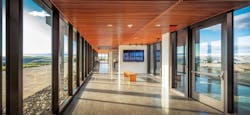The Maryhill Museum of Art in Goldendale, Wash., preserves and houses art and other historical artifacts that include more than 80 works by French sculptor Auguste Rodin. The facility was founded by railroad executive and lawyer Sam Hill after an attempt to develop a Quaker farming community and town on his remote 5,300-acre estate in 1907. The Hill mansion eventually was converted into a museum that officially opened to the public in 1940, nine years after Hill’s death. Mission Communications provides the monitoring and remote control equipment for the onsite water system, which supports the property’s HVAC and irrigation systems.
Remote Control Keeps Water Running
Groundwater from a natural spring feeds water to an onsite gravity-fed collection tank. Water then is pumped uphill to a 250,000-gal holding tank where it is fed to the museum for the HVAC system or used to irrigate museum grounds. Pump status and temperature, variable-frequency drive, flow rate and water level all are monitored at the collection tank. The water level is maintained via the tank and well control system. A level sensor is connected to the remote terminal unit (RTU) at the holding tank. When the water level drops below the predetermined set point, the holding tank RTU signals the collection tank RTU to activate the pumps and send water to the holding tank.
This system operates on cellular radios and remote servers. Cellular SCADA systems eliminate the need for expensive radios, phone lines and unsightly radio towers. Museum staff easily can access the wireless system via desktop computers or smartphones when they are working remotely. Continuous monitoring and remote control keep the water running efficiently, according to Kevin Freeman, Maryhill maintenance and grounds supervisor.
“The system monitors what is happening, so we know what’s going on,” Freeman said. “We are able to see how many gallons are in the holding tank, so we can make sure it never runs low.”
Real-time monitoring ensures there is always enough water for the HVAC system to maintain proper humidity and temperature control in the museum. Humidity or changing air conditions can permanently damage fine art.
“When the water level gets low, we need to know about it,” Freeman said. “It’s really important when you’re talking about millions of dollars of artwork that is at risk.”
Maintaining Optimum Water Levels
Freeman maintains the museum grounds and irrigation system, which pumps 200,000 gal of water per week for general maintenance. Real-time monitoring and remote control keep the holding tank at an optimum level.
“The most important information that the system gives me is the level of the holding tank,” Freeman said. “That is huge during heavy irrigation. There are also a lot of fires that happen around us, so the local fire department will draw water from our system to put out fires. I have to make sure there is enough water at all times to accommodate the various needs.”
Real-time alarms notify Freeman when levels drop too low in the holding tank. “We have the low level set at 2,800 gal, which is low, but not low enough to be an emergency,” Freeman said. “The alarm trigger levels are set in a way that allows us to be preemptive.”
The system has improved operational efficiency and reduced man hours spent checking the holding tank. Freeman said the most valuable aspect of the system is that he no longer has to drive to the holding tank a dozen times per day to check the level and make sure equipment is running properly. Freeman checks levels remotely from his computer or phone, giving him time for other daily tasks.
Lauryn Colquitt is marketing coordinator for Mission Communications. Colquitt can be reached at [email protected] or 678.969.0021.
